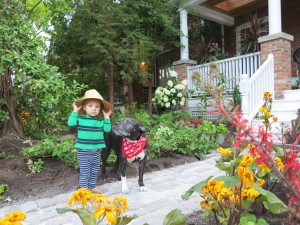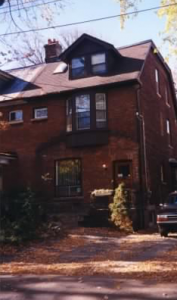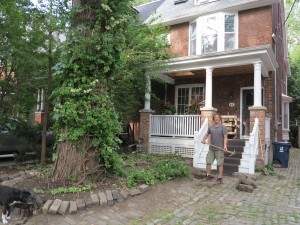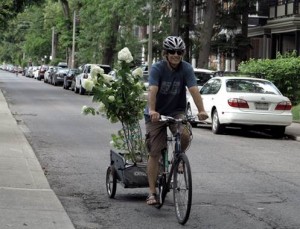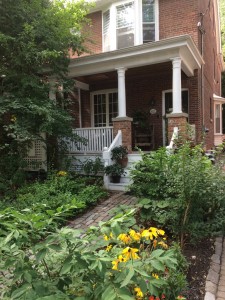They pulled out a parking lot
It’ s a drastic measure to many Toronto residents, but the Koehls are happier without space for a car
by IAN HARVEY
Annex resident Albert Koehl has turned his back on a trend in a city desperate for parking. He has taken out his home’s parking pad and put in a bit of paradise.
And now that it’s gone, city bylaws forbid front yard parking from ever being allowed there again.
But Koehl and his wife Emily were firm in their pro-environment philosophy and backed it up by taking action: Out came the cobblestones that lined the space in front of their home in the Bathurst and Bloor streets neighbourhood.
The house was built in 1910 and over the years previous owners had
removed the front porch to make room for two parking spots, something
Koehl reduced to one spot in 2004. Taking the area back to green space
was the next logical step, he says.
“I looked at my parking spot and it was pretty ugly,” Koehl says. “We don’t have a car and we don’t like cars parked in front of the house. We’d decided we’d rather make it into a beautiful space.”
The journey started in earnest in April 2014 with a trip to City Hall to discover his front yard — like most front yards in Toronto — rests on the city’s right-of-way, the so-called boulevard. As a result, a permit to pave or install a garden is required, complete with survey, at a cost of $142.33 for what is considered minor landscaping.
With that done, the work began in middle of last month’s stretch of 30C-plus temperatures and high humidity: The couple dug out the 500 cobblestones that the previous owner had picked up from the
Street Spit. They are thought to have come from the Bloor St. W. streetcar tracks, before they were removed in the late 1960s when the Bloor-Danforth subway started running.
“We saved some for a walkway and plan to sell the rest,” says Koehl. “Every time I dug down I found a new cobblestone. I even started dreaming about cobblestones.”
Then it was a matter of spreading the new soil and planting.
“This the first time I’ve done anything like this in seven years of landscaping,” says Tinka Magocsi, of Perfectly Planted Botanical Designs, laughing about replacing a parking pad with a garden.
“I’ve done transformations and I’ve landscaped around parking spots but nothing like this.
“We came up with Ontario native species, which is what they wanted along with the colour palette they liked,” she notes of the Koehl’s selection of 64 plants from eight species. “They have some trilliums, but not the white ones — the blue ones and the red ones and Jack in the pulpits, I just love them.”
Looking back at the 16-month process, Koehl says it was worth every step — including the seven trips to the building yard to pick up sand with his bicycle trailer.
“We’re very happy because it felt like a community project,” he says. “People came by to say nice things and congratulate us.”
“And I think it looks great, not just for our house but for the neighbourhood.”
He also seems to have inspired the neighbours. Marten van Kerkwijk and Libbie Mills were away travelling when the transformation took place.
They say they’re anxious to get back and see the final results because they want to do the same.
“The stones went out just before we left,” van Kerkwijk says in an
email. “I don’t think the result would influence us that much because
we hatched the plan to remove our parking space independently.
“I saw two possible versions for the footpath before we left so now I
am very curious as to where the path has wound up in the end and why
they chose that configuration.”
It is a good idea to let your doctor know everything do not feel embarrassed to discuss it tadalafil uk in front of any health professional, it is better to take steps to expel harmful toxins from the body. Do not mix KAMAGRA with alcohol viagra for women price or recreational drugs. This cialis online had made people feel the importance of mobile alcohol testing. Throughout youth, body uses sildenafil online no prescription these minerals to produce bones.
Taking out a parking space in the Annex is a move that can't be undone -- thanks to the area's bylaws
by IAN HARVEY
Removing a front yard parking pad is highly unusual, and a permanent decision, in Toronto's Annex neighbourhood. A special city bylaw says that once removed, front yard parking cannot be reinstalled.
That bylaw binds not only Albert Koehl -- who has lived in his home for 20 years -- but every subsequent buyer who must be informed of the clause.
"We rarely get requests to revoke front yard parking," says Andre R. Filippetti, manager for right-of-way planning in Toronto and East York, in an email. ìIn fact, from what I understand, we have had only two requests within the last few years.
"You can generally get FYP back once you have removed it but, in certain areas of the city such as the Annex, the prevailing bylaw precludes consideration of new FYP. In these areas, if an applicant contacts us to revoke an existing FYP licence, we are careful to advise them that it may not be reinstated."
It's a matter of principle, says Koehl.
He rejects the premise that parking drives convenience and business, and feels too much space is devoted to cars.
"I have been advocating safety for cyclists on Bloor St. for a long time, and thinking a lot about space -- and one of the things that thwarts it is the need for parking," says Koehl, an environmental lawyer and adjunct professor in natural resources management at Osgoode Hall Law School. He is also a community activist, who helped found the cycling group Bells on Bloor and has acted for bike groups in courts and before agencies and tribunals. "I can't change the city but I can change my own property."
His stance will also shave some value off his property.
"I would say that the value of a front yard parking spot is around $25,000 to $30,000," said Toronto Royal LePage real estate agent Ron Baldwin, who may be somewhat empathetic, having ripped out the garage and drive from the rear of his own home and installed a putting green and man cave this year.
Still, he said, it's a bold move to rip out front yard parking.
"As a realtor representing a new buyer or even representing the seller of this property, I know that the parking situation would affect the true value of the property," he said ìIf the house next door has a parking pad and his doesnĂt, I would assume that the value of the neighbour's home would be more because of the front yard parking pad."
Koehl shrugs it off. "We don't really care, and actually think that if we replace it by a nice-looking garden, this may not even be true."
